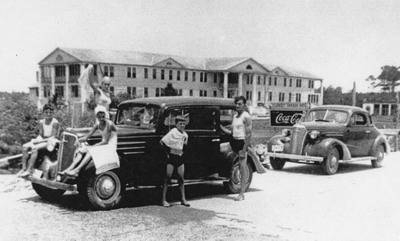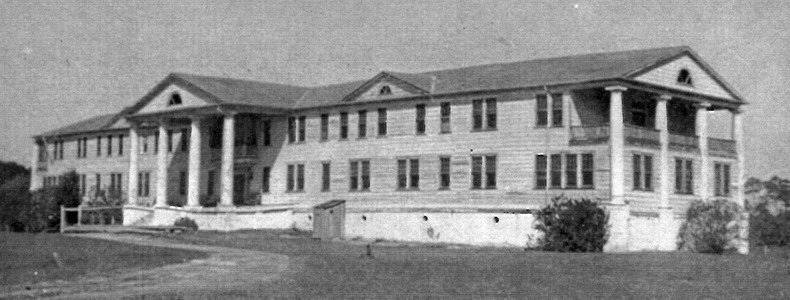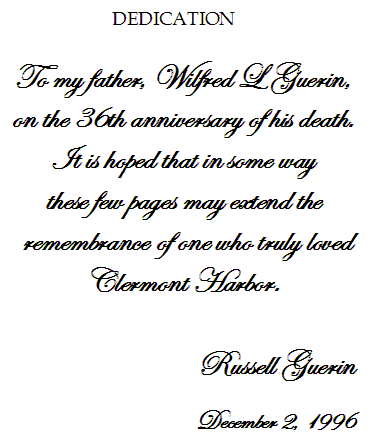Clermont Harbor Hotel
Some Facts, Some Faint Memories
(A small booklet printed by the Hancock County Historical society in 1996, written by Russell Guerin)
There is no more Clermont Harbor hotel, except in the memories and affections of some older people. It stood for many years as a landmark to sailors and shrimpers, as a curiosity to the passers-by, and as something the locals just took for granted. But it was always certainly a presence, a stately white prominence overlooking the sound and dominating the harbor beyond.
 Leisure Time at the Clermont Harbor Hotel
Leisure Time at the Clermont Harbor HotelIt was also a Jonah. I did not know the meaning of the word until the fire. That was when my father, one of the last owners, explained it to me.
None of the succession of owners was blessed with the art of timing, at least as far as the hotel was concerned. It was part of an ill-fated scheme to create a Riviera for New Orleans. It was nearly destroyed by a fierce hurricane in the first year of its existence, 1915. After an expensive attempt at restoration, it was wrecked financially by the great depression of 1929 and following. When a similar attempt was made in 1946, an early morning fire totally razed the structure on June 2; the grand reopening had been on June 1.
Made almost entirely of virgin cypress, its 40 rooms and 20 baths had survived the schooner that the ‘15 storm had hurled through its walls. It also made it through years of neglect and unoccupancy, except for the occasional uninvited guests who may have let themselves in clandestinely. The building even weathered the ignominious usage by some World War II traitors who reportedly sent signals from its higher reaches to confederates who were refueling German U-boats from Clermont Harbor. But, it was said by some, it could not survive the careless placement of a floundering flambeau in its basement on opening night.
We never knew for sure.
One thing is certain. It was not for the insurance. The Sea Coast Echo reported $11,000 of insurance against a value of $40,000. My own recollection was that the insurance was for $9,000 or less. At any rate, it was all my father had been able to buy, as Clermont Harbor then, as now, had no fire hydrants.
To know the story of the hotel, one may begin at the beginning. For Clermont Harbor, this traces back to February 28, 1837, when the U.S. Land Office at Jackson sold 571.34 acres at $1.25 per acre to Peter Chambliss and Charles Lacoste, of Natchez. The latter had evidently lost his enthusiasm for his half of the purchase by 1848, as he allowed part of it to be auctioned from the court house steps of Natchez for five cents per acre. This brought a total of $6.49 for $129.85 acres.
After a succession of owners, Joseph Lobrano sold to John Ioor and F. C. Bordage, Sr. for $1,000 in 1897. These gentlemen have been commemorated over the years by having two of the principal streets of Clermont named for them. The latter would appear to have been “Professor” Bordage, who had been principal of the Waveland public school and who had served as county deputy court clerk and assessor.
These owners, in 1898, filed a new plat with the county, calling the area simply “Clermont City.” This was not simply short for the current name, for the fact was that there was no harbor at the time, but only what was a low-lying marsh area.
The town evidently began to take shape in the next few years, for by 1910, there were 15 resident property owners, and five non-residents. It was in that year that a new entity appeared, by the name of Gulf Coast Development Corporation, which claimed to own 99% of Clermont City. This company filed a new plat with the county as Clermont Harbor. In the process, plans were detailed to widen streets and “to make the low part of said lands into a magnificent lake...“ for which “it has contracted for digging of lake at a cost of over $25,000.“
By the following year, the company borrowed $30,000 on a bond issue, with the Whitney Bank of New Orleans as Trustee. From the wording of the trust deed, it can be inferred that the purpose was to market lots. In this regard, this writer calls upon his early childhood memories when his father told him that at one time Clermont was being promoted to the people of New Orleans as their Riviera-to-be, and that lots were selling at high prices. Again by inference, the bond funds were probably used for the improvements such as a few sidewalks and structures that served as gateways to the town, and possibly a train depot and other beautifications. (The remains of the “gateways” still are in existence at Clermont Blvd. and the railroad.)
In June of 1913, Charles Hopkins, president of Gulf Coast Development, was given authority by the board of directors to act for the company in the sale of Clermont Harbor lots. In April of the next year, he purchased lots 6 to 18, square 37, at a cost of $3,853.62. He paid $2,603 in cash, the balance being financed on a note. This parcel was to become the site of the Clermont Harbor Hotel.
The dates of construction of the hotel building have not yet become evident. It must have been in place, however, by July 3, 1915, the date on which Hopkins borrowed $4,500 on a 30-day note to one George Mitcheson. This transaction required Hopkins to maintain $5,000 insurance, apparently on the building itself.
Meanwhile, the corporation must have been very busy. On May 14, 1915, GCD, in a Deed of Dedication, “conveys, warrants, assigns, transfers, sets over and dedicates to the said property owners of Clermont Harbor“ the following: lots 1 to 12, Block 42 (the so-called “water lots” lying on the Gulf side of Front St.), the motor boat harbor, pier, bathhouse, dancing pavilion, and all sidewalks. A committee of three property owners was to be appointed to oversee the maintenance of the above listed items. Trustees of this dedication were to be Hopkins and F. S. Walmsley. Also mentioned was a “wharf and appurtenances thereto...projecting 900 feet toward the sound.“ (My older brother, Wilfred, remembers that cars could drive onto a platform at the base of the pier. Even today, remnants of the pier can be seen at very low tide, running parallel to the channel that empties the harbor.)
On September 29, 1915, a hurricane with winds measuring at least 140 mph visited the Gulf Coast. It is known to have demolished the pier and heavily damaged the hotel. The aftermath of the storm is possibly reflected in county legal records. One year later, Hopkins borrowed an additional $2,400 on a 12-month note, pledging almost the entire hotel site, “with buildings and appurtenances thereon.“ That note was not recorded as paid until may 29, 1925. GCD was also revisiting the financial markets, borrowing in 1917, $16,000 on a bond issue, with Whitney Bank being Trustee. The trust deed pledged lots 1 to 5 and 19 to 22, Block 37, these being adjacent to the hotel site, and themselves being the site of the dancing pavilion. “Other” lots were also included.
Two years later, in October 1919, the bondholders petitioned for a substitution of the Whitney as trustee. This was approved, and E. J. Gex was named as trustee. At this time, Hopkins owned a majority of the bonds. In February of the following year, Gex sold on a foreclosure to Joseph Rhodes. It is recorded that this transaction took place on the court house steps “after sundry bids, J. L. Rhodes bid of $4,000 being the highest, last, and best.“ It is interesting to note that Rhodes had been Secretary-Treasurer of GCD, and had been proxy for Hopkins in the substitution of trustee. Hopkins was then living in Newport News, Virginia.
In 1921, Rhodes sold his parcel to Clermont Harbor Land Co. which in turn sold the pavilion site to Hopkins in 1925.
Mr. Hopkins apparently was now ready to try again to make the hotel a success. This entrepreneur had been developing subdivisions in Virginia, and previously had developed areas of New Orleans and Waveland. In the Virginia enterprises, Hopkins had employed Mr. Hugh Turner Carr, a construction superintendent in whom Hopkins had a great deal of trust. Carr, in his fascinating little book entitled My First Eighty Years aboard the Planet Earth, narrates that in September 1925 Hopkins came to Carr’s home with train tickets, accompanied by a key to a house in Clermont for which a year’s rent had been paid. With these items Hopkins made a request of Carr that he go and rebuild the hotel that had been nearly demolished by the 1915 hurricane. Carr goes on to recount one store, one post office, and millions of mosquitoes in Clermont Harbor, but he evidently fell in love with the area nonetheless. From 1925 on, Carr spent the rest of his life on the Mississippi Gulf Coast.
Carr’s work began with letters of introduction to local banks and businesses, verifying that Hopkins would be responsible for purchases made by Carr. The reconstruction proceeded well from the fall of 1925 through mid-1926, when “a special train from New Orleans, Louisiana, brought five hundred people for the opening.” The date was July 4, 1926. Carr says that there was standing room only in the hotel, but reports one sentence later that “this hotel was never a financial success.”
 Clermont Harbor Hotel
Clermont Harbor Hotel
Hopkins’ investment would appear to be heavy for the time, as he borrowed $15,000 on a one-year note in June 1926. A year later, he signed another note to a different lender for $15,300 to be repaid in two years. The trust deed covering this loan mentioned “all furniture, tableware, linen, and all equipment used in connection with the operation of said property as a hotel.” Hopkins also agreed to maintain $15,000 insurance on the “Buildings”, apparently inclusive of the dancing pavilion.
It would appear that the above note remained unpaid until February 1931 when Hopkins and his wife sold to Harbor Inn, Inc. The buyer assumed 19 promissory notes totaling $15,300. The president of Harbor Inn was R. Bland Logan.
The next 11 years did not see an appreciation of Harbor Inn, for on July 30, 1942, it passed to M. Bernhard, Sr. The price was $6,500 on the basis of $2,000 cash with the balance in notes to be paid by January 20, 1945.
Shortly after his purchase, Bernhard granted an option to my father, Wilfred L. Guerin, Sr. My father paid only one dollar for a 3-month option, but had it been exercised, the sale price would have been $8,000.
Guerin appears to have explored two possibilities before letting the option lapse. On November 9, he wrote to the U.S. Army Air Corps to inquire about the prospect of government housing of “personnel or workmen during, and perhaps after, construction of the field.” Apparently there had been some indication - perhaps rumor only - that an air field was to be constructed along Highway 90 just north of Clermont Harbor.
The second possibility involved the demolition of the hotel building, and the subsequent dividing into lots for sale. Judging from an undated circular, it is assumed that he tested the interest of possible prospects by mail. It is further assumed that due to either a lack of interest or to insufficient time, he let the option lapse.
On April 25, 1944, Bernhard entered into a complex agreement with Jeanette C. Carmichael, the express purpose of which was to effect a sale of the property. Again, the stipulated price was to be $8,000.
At the time of this writing, the exact date of sale by Bernhard is not clear. Nor is the selling price. It appears, however, that he sold to the Clermont Harbor Hotel Corporation, of which my father was president, either in late 1945 or early 1946. My recollection is that my father owned 51% of the corporate stock. I also remember that he worked extremely hard in the months preceding the opening date, June 1. He commuted from our home in New Orleans to the hotel almost daily, it seems, and I recall my mother saying that he literally turned grey in that period. I am sure that he felt at the time that the investment in money and in the time necessary to supervise the restoration, were worthwhile. It was after all, the accomplishment of a longed-for dream: an ambition of my father for many years had been to own the hotel.
My eldest brother, Wilfred Jr., has more vivid recall of some details. He remembers the arc-shaped drive leading up to the front steps beneath the four Roman columns of the portico. He and I also can picture the oleander plants flanking the steps, and remember that they must have already been old, judging by their size. Wilfred Jr.’s memory also includes the facts that the restaurant had been opened before the hotel, and that it was furnished with brand new kitchen equipment. He can still picture stacks of new mattresses which our father had had made in New Orleans. They were stuffed with Spanish moss. One of my own vivid images is of the interior of the attic and the enormity of the cypress beams; this was probably the only time my father allowed me to climb the stairs to the attic, from which I remember the view high up above the grounds.
In those days, we spent our summers joyously in Clermont from the day school ended until the day before school began again. But on the particular weekend of June 2, opening day for the refurbished Clermont Harbor Hotel, we were still in New Orleans, because my brother Roland and I had just graduated from grammar school. We had a house guest for the night, a fellow graduate, who overheard my father’s response to an early morning long distance call.
What we overheard was that the hotel was burning. Within hours, all that remained of the endeavors of many who loved the Clermont Harbor Hotel were its foundations, a spacious verandah, and four stark Roman columns, still reaching, monument-like, toward the sky.

SOURCES
- Extracts of title #898m made for Wilfred L. Guerin by E.S. Drake, November 7, 1945
- The New Orleans States
- The Sea Coast Echo
- My First Eighty Years aboard Planet Earth, by Hugh Carr
- Along the Gulf, originally published by the L&N Railroad, 1895
- Personal family papers, Wilfred L. and Carmela Cali Guerin
- “Hurricane” - a Familiarization Booklet - by U.S. Department of Commerce National Oceanic & Atmospheric Administration
There also appears a copy of an article from the Sea Coast Echo, dated June 7, 1946 as follows:
Clermont Harbor Hotel Burns - Clermont Harbor Inn was completely destroyed at an early hour Sunday. It was said that the building was almost completely burned before assistance reached the scene.
The building, a two-story frame structure, had 40 rooms and 20 baths, and had recently been purchased by a New Orleans corporation from a local owner and had been renovated and opened for business two weeks before it burned. The estimated value of the property was said to be $40,000 and carried $121,00 insurance. It is not known whether it will be rebuilt.
At the time of the fire there was said to be 40 guests registered who lost the greater part of their personal effects and some of whom got out in their night clothes.
The hotel has an interesting background with its struggles against the many obstacles which retarded its development. The hotel was built by Charles Hopkins, at that time living in New Orleans and was completed in 1915 and had opened for business when the 1915 storm struck this coast with a heavy force. The high winds drove a large schooner through the building doing considerable damage. After that it was leased several times to different parties but not successfully. Then H. E. Carr at the request of Mr. Hopkins came down from Washington and remodeled the building and raised it about ten feet and it appeared to be going to be a success. Buth the depression of the early 30-’s came on and the hotel became a losing proposition and passed into other hands. Mr. Wilford Guerin, New Orleans and summer resident of Clermont Harbor, manager and part owner of the hostelry has not given out any statement as to the plans of the owners. (SCE June 7 1946)
The booklet also includes a copy of the Sea Coast Echo, January 11, 1946 article
“The charter of Incorporation of the Clermont Harbor Hotel Corporation“